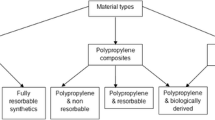Abstract
The biological evaluation of polypropylene (PP)/polyglactin 910 grafts was reviewed including regulatory considerations, biocompatibility assessment, tissue reaction and integration, and infection potentiation of these synthetic materials used in urogynecological surgical procedures. The physical characteristics of the grafts including base composition, monofilament vs multifilament, and non-absorbable vs absorbable materials were compared. Grafts were implanted in rats to evaluate the tissue reaction and integration characteristics of the materials over time. Grafts were also implanted in mice and inoculated with Staphylococcus aureus to assess the potential for bacterial attachment and growth. The tissue reaction to PP/polyglactin 910 grafts was characterized by minimal to mild inflammation with some qualitative differences related to the physical construction of the different grafts. The tissue reaction to polyglactin 910 mesh was also mild but resolved after the material was absorbed 70 days post-implantation. The integration of PP/polyglactin 910 grafts by fibrosis with surrounding tissue was initially mild for all materials but decreased over time for the lightweight and multifilament PP-based grafts, including a graft with an absorbable polyglactin 910 component. Residual fibrosis was not observed for the graft constructed from polyglactin 910 alone. Grafts constructed from PP did not potentiate infection after inoculation with S. aureus whereas the number of bacteria recovered from naturally derived collagen-based materials increased by three to four logs. The biological performance of PP/polyglactin 910 grafts is dependent on multiple factors including the composition and physical construction of the base materials, the overall biocompatibility of the materials, particularly tissue reaction and integration of the grafts, and the resistance of the grafts to bacterial attachment and growth.





Similar content being viewed by others
References
Hutchinson RW, Barbolt TA, Lieuallen WG (2001) Tissue reaction and integration of polypropylene-based surgical mesh in rats (Abstract). Presented at the annual Society for Biomaterials meeting, St. Paul, Minnesota, 25–29 April 2001
Bhende SR, Rothenburger SJ, Hough L, Barbolt TA (2003) An infection potentiation study of synthetic and naturally derived surgical mesh materials in mice (Abstract). Presented at the annual Society for Biomaterials meeting, 30 April–3 May 2003
Author information
Authors and Affiliations
Corresponding author
Rights and permissions
About this article
Cite this article
Barbolt, T.A. Biology of polypropylene/polyglactin 910 grafts. Int Urogynecol J 17 (Suppl 1), 26–30 (2006). https://doi.org/10.1007/s00192-006-0100-3
Published:
Issue Date:
DOI: https://doi.org/10.1007/s00192-006-0100-3




